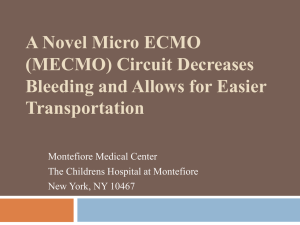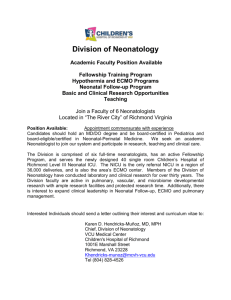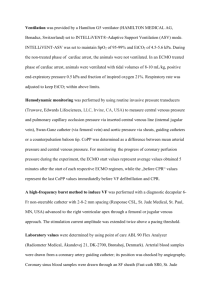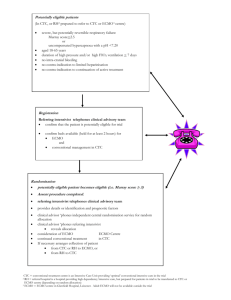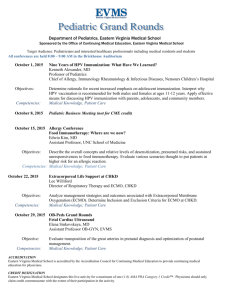ELSA Extracorporeal Life Support Assurance
advertisement
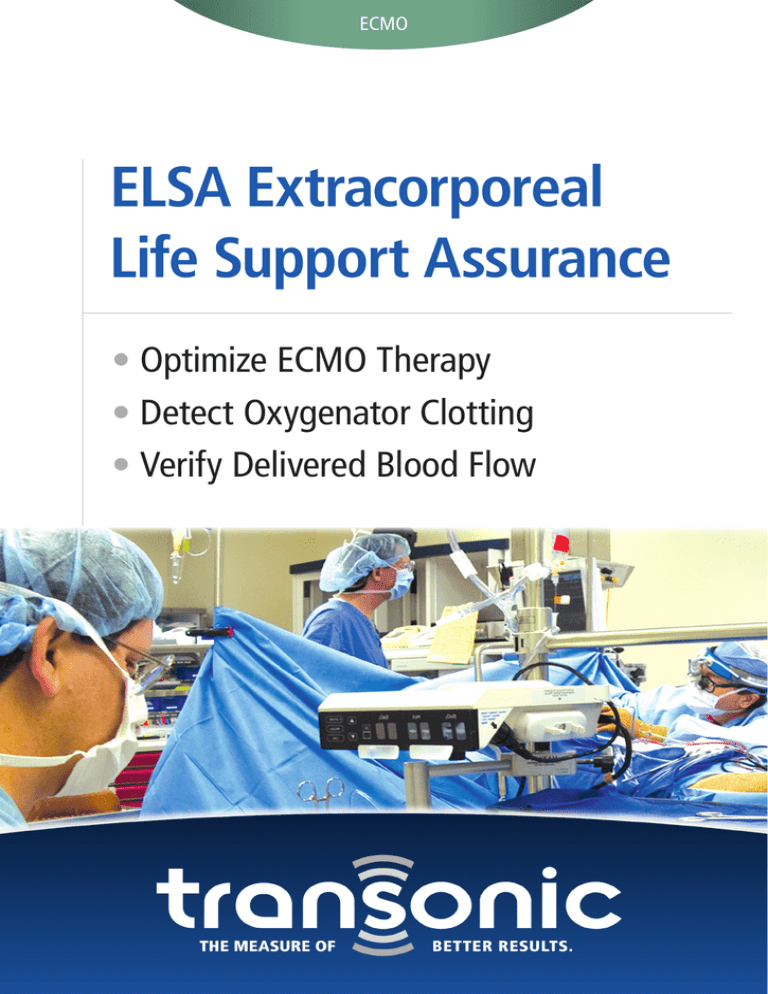
ECMO ELSA Extracorporeal Life Support Assurance • Optimize ECMO Therapy • Detect Oxygenator Clotting • Verify Delivered Blood Flow ECMO Optimize ECMO Therapy With Recirculation Percentage, Oxygenator Clot Detection, and Delivered Pump Flow Verification OPTIMIZE ECMO THERAPY DETECT OXYGENATOR CLOTTING The ELSA Monitor: • Guides optimal catheter placement and treatment delivery by helping to: • Establish a maximum pump setting before recirculation occurs; • Use known values for flow and recirculation to minimize the length of ECMO runs; • Identify cannula migration through high recirculation rates. • Identifies possible cardiac output failure during VV ECMO. With an injection of a small volume of saline, the ELSA Monitor measures oxygenator blood volume to identify early clot formation in the oxygenator of the ECMO circuit. Early detection of clot formation in ECMO circuits allows a wider window of opportunity to perform an oxygenator change-out. With a single bolus of saline, the Transonic® ELSA Monitor detects and quantifies recirculation in VV ECMO single- and dualcannula configurations. Clots in the ECMO circuit pose one of the major complications of ECMO. The challenge is to keep the oxygenator from clotting while preventing bleeding in fragile patients. VERIFY DELIVERED BLOOD FLOW Pump (delivered blood) flow errors and recirculation can compromise ECMO delivery of oxygenated blood. The Transonic® ELSA Monitor measures true delivered blood flow through ECMO tubing using “gold standard” transit-time ultrasound technology. By comparing actual delivered blood flow to the pump’s reading, any flow limiting cause such as incorrect cannula placement can be identified and corrected. Fig. 1: Oxygenator Blood Volume (OXBV) plus Recirculation Results screen during VV ECMO. Transonic Systems Inc., global manufacturer of biomedical flow measurement equipment, sells “gold standard” ultrasound transit-time flowmeters, hemodialysis, endovascular and laser Doppler perfusion monitors worldwide to surgeons, nephrologists, interventional radiologists, researchers and original equipment manufacturers (OEMs). AMERICAS EUROPE ASIA/PACIFIC JAPAN Transonic Systems Inc. 34 Dutch Mill Rd. Ithaca, NY 14850 U.S.A. Tel: +1 607-257-5300 Fax: +1 607-257-7256 support@transonic.com Transonic Europe B.V. Business Park Stein 205 6181 MB Elsloo The Netherlands Tel: +31 43-407-7200 Fax: +31 43-407-7201 europe@transonic.com Transonic Asia Inc. 6F-3 No 5 Hangsiang Rd Dayuan, Taoyuan County 33747 Taiwan, R.O.C. Tel: +886 3399-5806 Fax: +886 3399-5805 support@transonicasia.com Transonic Japan Inc. KS BLdg 201,735-4 Kita-Akitsu Tokorozawa SAITAMA 359-0038 Japan Tel: +81 4-2946-8541 Fax: +81 04-2946-8542 japan@transonic.com ELSACoverSheet(ELS-200-fly-A4) RevD 2015 ECMO Predicting Oxygenator Clotting with the ELSA Monitor Clots in the ECMO circuit are a common mechanical complication, causing patient complications, and oxygenator failure. The ELSA bedside Monitor uses dilution technique to measure Oxygenator Blood Volume. As clots form within the oxygenator, the circulating blood volume decreases. The ELSA Monitor provides quantitative assessment of oxygenator clotting and thereby predicts its increased thrombotic risk to the patient, and diminished oxygenator performance. % Oxygenator Blood Volumes –versus- ECMO time in hours ELSAClotPrediction(ELS-220-tn)RevA2014A4 www.transonic.com ECMO ELSA Recirculation & ECMO Cardiac Flow The ELSA Monitor measures Delivered Flow, Recirculation and ECMO Cardiac Flow (ECF). These measurements allow adjustment of Pump Flow and Catheter Placement to optimize ECMO therapy in VV ECMO patients. • Delivered Flow (DLVFLW) is an actual measurement of blood flow in the ECMO lines (within the Monitor’s measurement accuracy). • ECMO Cardiac Flow is the oxygenated blood flow delivered by the pump to the heart. ECMO Cardiac Flow (ECF) = DLVFLW[1 – (% Recirculation Value/100)] The higher the Recirculation, ELSA Monitor screen showing 0% Recirculation where ECF = Flow the lower the ECF If increasing Pump Flow leads to increased Recirculation and no change or minimum change in ECF, the pump setting is not delivering the optimal flow. 21% Recirculation, note that ECF is lower than the recorded flow ELSARecirc-ECMOCardiacFlow(EC-222-tn)RevB 2015 www.transonic.com ECMO ELSA Theory of Operation Fig. 1: Schematic showing placement of Flow/dilution Sensors and site of saline bolus injection in VV ECMO circuit. DIFFERENTIAL TRANSIT-TIME ULTRASOUND HOW IT WORKS A clip-on sensor transmits a beam of ultrasound through the blood line. Four transducers pass ultrasonic signals back and forth, alternately intersecting the flowing blood in upstream and downstream Clamp-on Flow/Dilution Sensor directions. The ELSA Monitor derives an accurate measure of the changes in the time it takes for the wave of ultrasound to travel from one pair of transducers to the other (“transit time”) resulting from the flow of blood in the vessel. The difference between the upstream and downstream transit times provides a measure of volume flow. ULTRASOUND INDICATOR DILUTION: HOW IT WORKS The velocity of ultrasound in blood (1560-1590 m/sec) is determined primarily by its blood protein concentration. The Transonic® ELSA Monitor and Flow/ dilution Sensors measure ultrasound velocity. A bolus of isotonic saline (ultrasound velocity: 1533 m/sec) introduced into the blood stream dilutes the blood and reduces the ultrasound velocity. The sensor records this saline bolus as an indicator dilution curve. RECIRCULATION When a saline bolus is injected upstream from the arterial Flowsensor, the ELSA Monitor identifies the saline concentrations at both Flowsensors. The ratio of indicator concentrations equals recirculation (Fig. 3). Rec= Sv/Sa*100%; where Sv and Sa are areas under arterial and venous dilution curves respectively. OXYGENATOR BLOOD VOLUME MEASUREMENT When a saline bolus is injected upstream from the oxygenator, the time that the indicator takes to travel through the oxygenator is proportional to its blood volume. OXBV = Qb * MTT; where Qb is blood flow through oxygenator and MTT is mean transit time of indicator travel through oxygenator. Percent change of OXBV% in time can be expressed: OXBV% = OXBVt / OXBVi*100%; where OXBVt is the value of OXBV measured at any moment in the ECMO process. OXBVi – initial OXBV measured at the beginning of ECMO process when oxygenator is free of clots. Fig. 2: Recirculation Results screen during VV ECMO. ELSATheory of Operation(EC-10-tn-A4)RevB 2015 www.transonic.com ECMO ELSA® References Körver EP, Ganushchak YM, Simons AP, Donker DW, Maessen JG, Weerwind PW, “Quantification of recirculation as an adjuvant to transthoracic echocardiography for optimization of duallumen extracorporeal life support,” Intensive Care Med. 2012 38(5): 906-909. (Transonic Reference # ELS9679AH) Said MM, Mikesell GT, Rivera O, Khodayar RaisBahrami K, “Precision and Accuracy of the New Transonic ELSA Monitor to Quantify Oxygenator Blood Volume (in-vivo and invitro studies),” 2015 PAS Annual Meeting and Eastern SPR Annual Meeting. (Transonic Reference # ELS10230V) Said MM, Mikesell GT, Rivera O, Khodayar Rais-Bahrami K, “Influence of central hemodynamics and dual-lumen catheter positioning on recirculation in neonatal venovenous ECMO,” 2015 PAS Annual Meeting and Eastern SPR Annual Meeting. (Transonic Reference # ELS10231V) Darling EM, Crowell T, Searles BE, “Use of dilutional ultrasound monitoring to detect changes in recirculation during venovenous extracorporeal membrane oxygenation in swine,” ASAIO J 2006; 52(5): 522-4. (Transonic Reference # 7309A) Körver EP, Ganushchak YM, Simons AP, Donker DW, Maessen JG, Weerwind PW, “Quantification of recirculation as an adjuvant to transthoracic echocardiography for optimization of duallumen extracorporeal life support,” Intensive Care Med 2012; 38(5): 906-909. (Transonic Reference # ELS9679AH) van Heijst AF, van der Staak FH, de Haan AF, Liem KD, Festen C, Geven WB, van de Bor M., “Recirculation in double lumen catheter veno-venous extracorporeal membrane oxygenation measured by an ultrasound dilution technique,” ASAIO J, 2001; 47(4): 372-6. (Transonic Reference # HD49V) Walker J, Primmer J, Searles BE, Darling EM, “The potential of accurate SvO2 monitoring during venovenous extracorporeal membrane oxygenation: an in vitro model using ultrasound dilution,” Perfusion 2007; 22(4): 23944. (Transonic Reference # 7594A) Walker JL, Gelfond J, Zarzabal LA, Darling E, “Calculating mixed venous saturation during veno-venous extracorporeal membrane oxygenation,” Perfusion. 2009; 24(5): 333-9. (Transonic Reference # 7904A) Melchior R, Darling E, Terry B, Gunst G, Searles B, “A novel method of measuring cardiac output in infants following extracorporeal procedures: preliminary validation in a swine model,” Perfusion 2005; 20(6): 323-7. (Transonic Reference # 10234A) ELSAReferences(EC-1-ref)RevA2015A4 www.transonic.com
